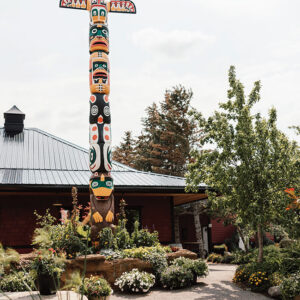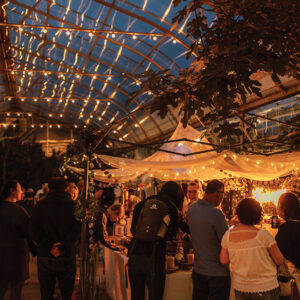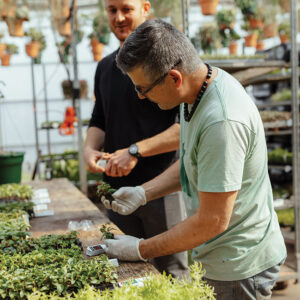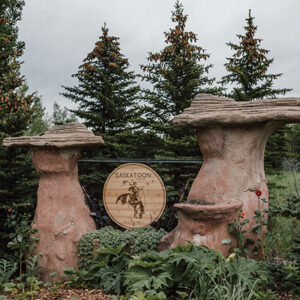
Features
This farm’s no secret to 1,000+ visitors a day
Alberta family transforms beat-up barley field into agritourism hot spot
November 13, 2023 By John Dietz
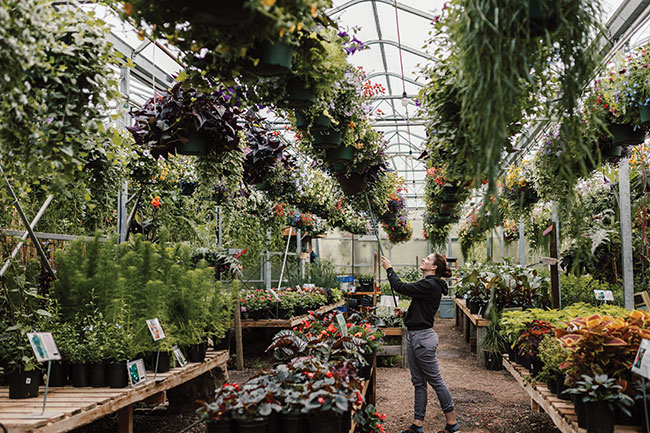 Saskatoon Farm, located near Okotoks, Alta., saw its first greenhouse built in the late 80s to grow saskatoon berry seedlings. Today, there is approximately an acre of greenhouses on the farm.
Photos: Elena Matkovska Photography
Saskatoon Farm, located near Okotoks, Alta., saw its first greenhouse built in the late 80s to grow saskatoon berry seedlings. Today, there is approximately an acre of greenhouses on the farm.
Photos: Elena Matkovska Photography ‘Yes, 37 years ago, this was a bare-bones, beat-up barley field. Now, we’re dining in what used to be our first greenhouse. Tomorrow, we’ll see where the kids want to take it.’
Paul and Karen Hamer sometimes have that conversation with visitors and customers at their place, The Saskatoon Farm. It’s only a 20-minute drive south of Calgary and five minutes east of Okotoks.
They found it as an isolated southern Alberta landscape with cattle, pasture, fields, slopes, and wild shrubs. From the land above, they were overlooking the convergence of two Prairie rivers coming across the foothills from the Rocky Mountains. To them, the sight and opportunity was priceless.
The Hamers graduated together from Olds College in 1977 with horticulture degrees. By the summer of 1986, they were living on a beautiful farm at Priddis and enjoying baby Seann, the first of three. One day that summer, tubing down the Highwood River valley, they stopped to pick wild berries.
Karen recalls: “Paul said, ‘One day I’m going to grow saskatoons here, and all kinds of fruit.’ He was such a dreamer, and he was a doer. The next year, 1987, we bought that farm. That was the start. I was 27, he was 29.”
She adds, “That summer, we lived in a tent down at the river. Paul and his sister planted the first saskatoons.”
Paul had a vision for a saskatoon farm with acres of the delicious, semi-wild, purple Prairie berry, and large numbers of people coming out to pick them from Calgary.
“Paul had to grow his own saskatoon shrubs because nobody had the quantity he wanted. He planted well over 18 acres of them that year, by hand, with a spade. We had 221 acres at the start.”
That was the beginning. They named it, The Saskatoon Farm.
Second Stage – Greenhouses
The original orchard was in the valley of the Highwood and Sheep rivers. The valley is about two-kilometres wide with a gentle flood plain and a sharp slope up more than 100 feet to the farmland. The Hamers acquired another 500 acres on the upland in the next five years, brought in a family home, had another son (Austin), and then a daughter (Johanna).
Karen recalls, “They told us at one point that they might not be able to get us heating and electrical service in time for winter. I went down with the baby, did a little complaint, and they certainly got it to us right away.”
Paul was just getting started. He had a vision.
“The next year, we built the big greenhouse to accommodate saskatoon seedlings. That became our main business,” she says. “For a long time, really, we were just growing saskatoons. We shipped them all over the world – to Finland, England, and Africa – but mostly within Canada. And that helped to pay for a lot of our growing pain.”
The first ten years, she admits, were “a bit of a struggle” as they stretched energy and resources to develop their agribusiness vision. “We did other projects as well. Paul was an award-winning landscaper. He did that to help pay the bills. Now we can’t possibly think about that, we’re too busy.”
When saskatoon shoots weren’t available to plant, Paul began buying and planting stock for a tree nursery. “We couldn’t get saskatoons, so we grew trees that turned into the nursery part of our business,” Karen says.
Seann recalls, as a teen, seeing shipments of a hardy new fruit-bearing seedlings arrive around the turn of the Millennium. It was a sour cherry from the University of Saskatchewan. Horticulturist Dr. Bob Bors planted the first sour cherry orchard in Saskatchewan in 1999 and soon after, sent the same stock to Paul Hamer to start Alberta’s first sour cherry orchard. He started with about a half-acre.
The lowland plantings were successful, with the Hamer family living on the upland above the valley, enjoying the view. After a few years, they began planting saskatoons and sour cherries close to home, eventually displacing about 50 acres of barley.
Seann is now the chief number-cruncher for the family and a second-generation horticulturist.
He says, “We have 40 acres of Northline saskatoons and about ten acres of sour cherries in several varieties. We’ve also got an apple orchard (probably two acres) that we started around 2010. It’s just for fun, but we do let people U-pick apples. “
The newest line of fruit is Paul’s Pear. Karen says, “Paul patented that around 2015. It’s an unbelievable producer, the biggest pear you can buy in Alberta. We sell a lot of them now.”
More seedlings needed more greenhouse space. A second greenhouse was built across from the first, around 1998, more followed, sometimes one-a-year.
Seann says, “Over the years, we just added on. I think we have about an acre of greenhouse space now in two groups. A couple have roll-up sides; the rest are Venlo-style with automatic roof vents.”
The kids grew and the farm grew. Seann, Austin and Johanna now live in their own family homes on The Saskatoon Farm. There are three grandchildren ‘on the ground’ and three expected in 2024. All of them work on the farm either full- or part-time. In addition, Karen says, the farm has 14 seasonal Mexican workers, who comprise the nearly 100-person staff during the peak season.
Agri-tourism today
Today, the second greenhouse is a “major sales” open-air market. On a typical summer Saturday, the Hamer’s see about 2,000 visitors touring, shopping, and picking.
“We have a pretty big push in the spring. We did just over 13,000 hanging baskets this year. Then, we did maybe 15,000 gallon and two-gallon pots of annuals on the floor below the baskets. We had good-sized tomatoes, herbs and all your standard garden centre stuff,” Seann says.
All of the spring planting supplies were gone by the end of June and replaced with fresh garden produce arranged for retail sales in summer and through the fall.
Special events dot their seasons, from the Summer Solstice night market with fireworks to the annual Christmas Market, looking like a Hallmark Christmas movie. Each market is a celebration of the season.
On the main street, across from the retail greenhouse was the original greenhouse.
“That’s where our restaurant is now,” Seann says. “We finished it in 2006 or 2007.”
The licensed restaurant seats 100-plus people, specializing in Mexican cuisine in an open-air rustic board-and-nail western theme. Upstairs, a business office overlooks a transformed landscape of trees, structures, sculptures, potted plants, rocks, pathways and totem poles.
From May to October, the ‘farm’ soaks up a typical daily attendance of a thousand people and more, shopping for flowers, bedding plants, trees, shrubs, lawn ornaments, vegetables, picking fruit, relaxing, dining, sight-seeing, and taking pictures.
Country lane
Most visitors come off a modern open four-lane divided Highway 2. They can turn west into Okotoks or turn east for a two-minute drive to The Saskatoon Farm. Half a kilometre of tree-lined canopy covers the hard-packed farm lane on the other side of the arbor entrance.
“Paul planted every tree, and he was still planting trees this summer,” Karen says. From the lane, you don’t see fields; you see thickets of green leaves in summer and then glimpses of greenhouses and rows of market gardens.
On the left, an opening emerges to the first of four parking areas for visitors. From there, people are on foot, walking in the lane, talking, carrying things, going both directions.
The lane opens for foot traffic into the main receiving area about 150-metres long. It becomes a maze of buildings and heavily planted rock gardens. Two wide red, hip-roof style barns, side by side, need a second look. They conceal two greenhouses. Benches and picnic tables invite relaxation.
Up ahead, nestled among trees, the pathway divides a cluster of four decorative and tall totem poles along with four windmills speaking of bygone eras.
Behind the poles to the left is the appearance of a western village, with two-story storefronts. A wall of green teapots embedded in clay is beside one entrance, and a wall of yellow teapots is behind another. Karen grins, saying she had too many to sell so she ‘buried’ them.
Behind the ‘village’ is a large open area enclosed by poles and a roof, decorated with hanging pots of flowers, massive turtles, and tall planters on the floor, filled with sprawling banana trees. It’s a venue, waiting to be filled with weddings and other events.
To the right, choices await for greenhouses to visit. There is a petting zoo with small animals, some caged and some walking with the visitors. The whole area is flat, open, mostly wheelchair accessible. There are boulders for boys to climb and, in season, apples to pick. Flowers are everywhere.
When visitors reach the far side, later, they find a scenic Prairie panorama opening to the east and places to sit enjoying the view. It’s like a gift from a pair of horticulturists, overlooking the Highwood River and fields of grain further east.
Print this page
